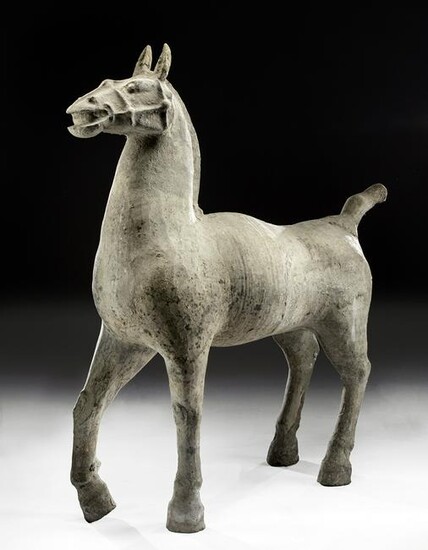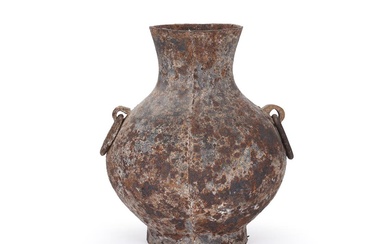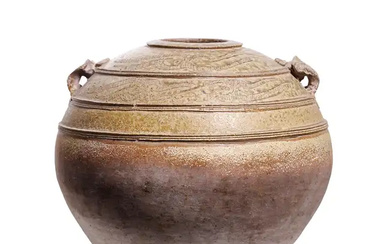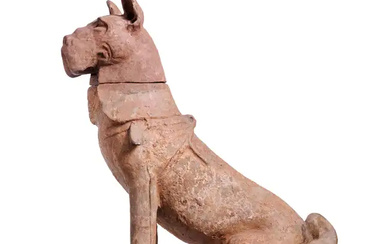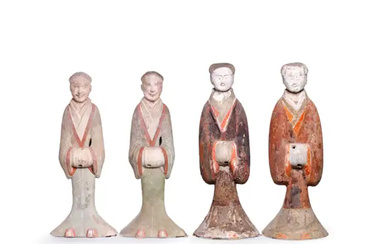Very Large Chinese Han Dynasty Pottery Horse w/ TL
East Asia, China, Han Dynasty, ca. 206 BCE to 220 CE. An handsome, foal-sized ceramic horse, striding forward with his front right hoof lifted. His face is expressive, with wide-open eyes, a pronounced snout with flared nostrils, an open mouth revealing his teeth, raised alert ears, a neatly manicured mane, raised and curled tail, and a finely delineated relief bridle. The sculptor skillfully delineated the muscular body of this noble steed, giving it a lifelike appearance with the head more stylized in Han convention. In ancient China, people placed such model figures in tombs to ensure a safe journey to the afterlife. One of this size would have graced the tomb of the most elite. Size: 32" L x 10.25" W x 36.75" H (81.3 cm x 26 cm x 93.3 cm)
During this period of Chinese history, horses came from the Ferghama Valley in Central Asia - present day Afghanistan. When elite individuals passed away, large "walking" terracotta Ferghama horses displaying an immense degree of attention to detail, like this example, were created to carry the deceased into the hereafter. The horse, second only in importance to the dragon, was believed to possess magical powers. The number of horses owned by an individual ensured his high status in the afterlife.
Funerary sculptures like this piece are part of a class of artifacts called mingqi - sometimes known as "spirit utensils" or "vessels for ghosts". They became popular in the Han Dynasty and would persist for several centuries. Alongside figures like this one were musicians, athletes, animals, structures … Even though they were mass produced, mingqi of the Han Dynasty often show a high level of detail and naturalism. These were designed to assist the po, the part of the soul of the deceased that remained underground with the body while the hun, the other part of the soul, ascended. Caring for the po seems to have taken on a new level of meaning in the Han period, with more elaborate rituals and tomb construction arising.
This piece has been tested using thermoluminescence (TL) analysis and has been found to be ancient and of the period stated. A full report will accompany purchase.
Provenance: private California, USA collection of the late Karming Wong; approximate date of acquisition: late 1970 to early 1980
All items legal to buy/sell under U.S. Statute covering cultural patrimony Code 2600, CHAPTER 14, and are guaranteed to be as described or your money back.
A Certificate of Authenticity will accompany all winning bids.
We ship worldwide to most countries and handle all shipping in-house for your convenience.
#155877
Condition Report: Legs are professionally restored from new material. The rest of the body has been repaired and restored in a few places, but appears to be in very good condition. The tail and ears have been reattached with some small added clay to re-affix them. Several small holes drilled for TL testing.
View it on
Estimate
Time, Location
Auction House
East Asia, China, Han Dynasty, ca. 206 BCE to 220 CE. An handsome, foal-sized ceramic horse, striding forward with his front right hoof lifted. His face is expressive, with wide-open eyes, a pronounced snout with flared nostrils, an open mouth revealing his teeth, raised alert ears, a neatly manicured mane, raised and curled tail, and a finely delineated relief bridle. The sculptor skillfully delineated the muscular body of this noble steed, giving it a lifelike appearance with the head more stylized in Han convention. In ancient China, people placed such model figures in tombs to ensure a safe journey to the afterlife. One of this size would have graced the tomb of the most elite. Size: 32" L x 10.25" W x 36.75" H (81.3 cm x 26 cm x 93.3 cm)
During this period of Chinese history, horses came from the Ferghama Valley in Central Asia - present day Afghanistan. When elite individuals passed away, large "walking" terracotta Ferghama horses displaying an immense degree of attention to detail, like this example, were created to carry the deceased into the hereafter. The horse, second only in importance to the dragon, was believed to possess magical powers. The number of horses owned by an individual ensured his high status in the afterlife.
Funerary sculptures like this piece are part of a class of artifacts called mingqi - sometimes known as "spirit utensils" or "vessels for ghosts". They became popular in the Han Dynasty and would persist for several centuries. Alongside figures like this one were musicians, athletes, animals, structures … Even though they were mass produced, mingqi of the Han Dynasty often show a high level of detail and naturalism. These were designed to assist the po, the part of the soul of the deceased that remained underground with the body while the hun, the other part of the soul, ascended. Caring for the po seems to have taken on a new level of meaning in the Han period, with more elaborate rituals and tomb construction arising.
This piece has been tested using thermoluminescence (TL) analysis and has been found to be ancient and of the period stated. A full report will accompany purchase.
Provenance: private California, USA collection of the late Karming Wong; approximate date of acquisition: late 1970 to early 1980
All items legal to buy/sell under U.S. Statute covering cultural patrimony Code 2600, CHAPTER 14, and are guaranteed to be as described or your money back.
A Certificate of Authenticity will accompany all winning bids.
We ship worldwide to most countries and handle all shipping in-house for your convenience.
#155877
Condition Report: Legs are professionally restored from new material. The rest of the body has been repaired and restored in a few places, but appears to be in very good condition. The tail and ears have been reattached with some small added clay to re-affix them. Several small holes drilled for TL testing.
